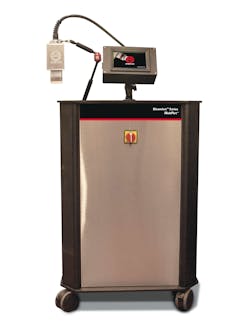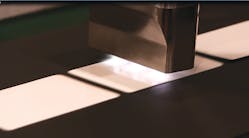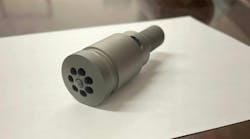Once considered cost-prohibitive by many manufacturers, plasma treatment may be coming to a surface near you. A number of trends are sparking growing interest in the technology, which can be used to change the properties of plastics to improve their suitability for processes such as printing, coating and lamination, according to Wilson Lee, director of business development at Enercon Industries. Thanks to new technologies, the approach now is more economically accessible, and appropriate for larger sizes of parts.
Plasma treatment, in particular, finds use in a growing number of areas for its “green” characteristics and ability to replace solvents and other fluids that may pose workplace hazards.
“Plasma is a green technology,” Lee said. “Many alkaline cleaning solvents require multiple levels of safety precautions to use around people. Additionally, the disposal of these solvents is highly regulated. With plasma, you can eliminate all of these issues while still producing the same results.”
Lee said that plasma is used to perform a variety of functions. It can make surfaces glossier or more matte, and it can be used to bond unlike materials — such as metal to plastic. “Anytime you bond two dissimilar materials together, you’re going to have a problem,” he said.
Among recent trends, Lee said plasma is being used to clean parts, as well as to prep cable. Increasingly, it’s also being used on parts that are wider than previously thought practical to plasma- treat. Manufacturers that have shown interest in the technology include automotive parts suppliers, cable makers and medical-device companies.
Plasma can create a “nice, clean edge” on parts that require a bit of post-processing after coming out a mold. “There’s … applications where someone will be molding a part and when they pull the part out of the mold, there will be what we call ‘hairs,’ ” Lee said. That’s the case with condiment containers.
The growing use of composite materials and additives, such as flame retardants, also is driving demand for plasma treatment technologies, he said. Automakers, for example, are under pressure to reduce part weight and have embraced composites, but the newer materials are often poor substrates for bonding or printing.
Lee pointed to the composites that are used to make aircraft wings and car parts. Traditionally, people hand-sanded the structures and used solvents to expose the base carbon fiber so it could be bonded to other parts. The process is labor- intensive and produces inconsistent results. “There’s a great variance in bond strength,” he said. “There might be 50 people in a room all sanding it down, but all 50 people do it differently.”
Cables made for ships or applications that require wide temperature variances also often are plasma-treated. Lee said the company is expecting a 60 percent increase in that market, and, to accommodate users’ needs, it provides 3-kilowatt (kW) and 5-kW treatment units that can be used inline as cable is prepared for printing. Its Blown-ion 500 plasma treater can treat cable flying past at speeds of up to 1,000 feet per minute.
The company also provides special units just for window and door applications, in which manufacturers are trying to bond materials such as fiberglass to plastic. Each unit, Lee said, has a “very odd head or nozzle on it” that treats multiple spots at once.
Lee said over the past few years, new designs have made plasma treaters better able to economically handle wider-width parts, making the technology more accessible.
For example, though manufacturers use plasma to prepare syringe surfaces for printing and plastic catheter components for bonding, the technology once seemed ill-suited for wider medical parts such as IV bags. IV bags have been traditionally treated with flame applicators, but, as plasma technology advances, Lee said parts makers are realizing the economic advantages of plasma.
“Almost every manufacturer is incorporating printing, bonding, painting or coating to a product at one stage or another,” he said. “A single plasma jet costs about $0.15 per hour to operate and, since there are no moving parts, plasma units can last 10 or 20 years with almost no maintenance. Changing the electrode every couple thousand hours of operation will keep manufacturers producing consistent high-quality parts.”
Increasingly, IV bag makers now use plasma to prepare their parts’ surfaces for printing. According to Lee, it’s just one of the myriad ways plasma is making its mark throughout the plastics industry.
“We are at the beginning of recognizing the benefits and applications for plasma surface treatment. Its use is more widespread than ever and growing every year,” he said.
Pat Toensmeier, correspondent
Karen Hanna, copy editor
Contact:
Enercon Industries Corp. Menomonee Falls, Wis., 262-255-6070,








